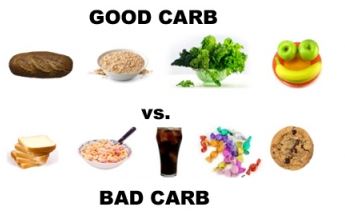INTRO PART 4 – TIME TO START






We ran across an interesting video online. The authors have taken different foods and compared them on the same size plate for the same 200 calories. It’s fascinating to watch, but I think you’ll soon find the fried food, high in sugar, etc are the smallest foods. Your stomach gets fuller with the right types of foods. There are many other factors to the correct food selection like glycemic index, processed foods, chemicals, etc. But starting off with basic SIZE is a good way to tell if you might be eating the right foods.
Cheers…Jay

Low carb, high carb, carb cycling – what’s the deal? Here’s the science:
Carbohydrates are a primary source of energy for your body. However, there are many different types of carbohydrates that work differently in your body. Recently, carbohydrates have gotten a bad reputation so you hear ‘low carb’ and ‘no carb’ thrown around quite a bit. What are you supposed to avoid? How much can you eat – if you can eat it anyway?
In science, the definition of simple carbs and complex carbs is different from ‘clean eating’ talk. Simple carbohydrates are simply sugars (glucose, fructose, galactose) and the sugars made out of these sugars (sucrose, maltose, lactose). There are simple carbohydrates in your fruit and milk – they are good for your body! Simple carbs are digested faster than complex carbs as they are single or double chained sugars.
Complex carbohydrates consist of polysaccharides (multiple chain sugars) such as starches and fiber, as well as oligosaccharides like beans and take longer to digest. Starches are composed of amylose and amylopectin which is digested differently than simple sugars like glucose and fructose. However, eventually all sugars will be broken down into simple sugars by enzymes to be burned for energy or converted into glycogen or fat.
There are three things that occur when you consume carbohydrates (this is simplified).
A simple good rule of thumb to follow for ‘good carbs’ and ‘bad carbs’ is as follows:

Good carbs – fruits, vegetables, legumes and whole grains.*
Bad carbs – refined grains, sweets and alcohol (beer).
*Make sure you are buying 100% Whole Grain foods – it will be stated on the label! Some products will contain whole grains, but won’t be 100% whole grain.
The Institute of Medicine recommends that 45-65% of your calorie intake should come from carbohydrates and at least 130 grams a day. However, lowering your carb intake and increasing protein intake can help reduce your total calorie intake for weight loss. Experiment with your carbs and do what feels right for your body! Tired, foggy, lazy? Check your carb intake!

Glycemic index is an index that rates how quickly carbs get converted to glucose in the body. The scale is from 0 to 100 with 100 being the quickest converting foods. Glucose itself is given a rating of 100. So why is this important? Your body is at its best when blood sugar is kept as close to constant as possible. Blood sugar that is too low causes increased hunger and makes you feel tired. If it’s too high, your body will release insulin, which in turn will drive the blood sugar low again. You can definitely increase your rate of fat storage. For a more complete treatment of the glycemic index, check out.
http://nutritiondata.self.com/topics/glycemic-index
Here is a great quick list of the glycemic index of common foods. Check out rice, potatoes, etc. You’d be surprised how high of a value they have. Seemingly healthy recipes can kill your blood sugar.
http://www.health.harvard.edu/healthy-eating/glycemic_index_and_glycemic_load_for_100_foods
The image above is from MedicineNet, Inc. You can find out more about the Pancreas which is responsible for scremeting pancreatic juices and hormones, including insulin. http://www.medicinenet.com/image-collection/pancreas_picture_1/picture.htm